The Perfect Three Day Kyoto Itinerary: City of a Thousand Temples
Kyoto is one of the most unique and beautiful cities in Japan and with three days in Kyoto, you can see many of the top sights. This itinerary will take you to all the best stops in the historic districts of Gion and Higashiyama, have you hiking underneath thousands of torii gates at Fushimi Inari, sipping matcha in Uji, and feeling the calm of walking under towering bamboo in Arashiyama.
I was immediately taken in by the charm of Kyoto. Walking in the footsteps of history, Kyoto feels like stepping back in time. There are magical moments to be felt here at the most unexpected times.
Kyoto is incredibly popular so for the perfect vacation here, you need to be prepared to visit the sights during less popular times. If you are traveling from the Western Hemisphere, Kyoto is the ideal place to visit first as the jetlag means you will wake up extra early to beat the crowds. This three-day itinerary for Kyoto has all the details you need to plan your dream vacation.
Spending three days here was the highlight of my time in Japan and I can’t wait to return.
This post contains affiliate links, If you make a purchase through these links I will earn a commission at no extra cost to you. Thank you!
Planning your trip to Kyoto? Below are some places to stay, things to do, and more.
Best food Experiences in Kyoto- Tea Ceremony at Jotokuji Temple (Very popular!)
- Nishiki Market Brunch Walking Food Tour (great last morning tour!)
- Sake Brewery Tour with Sake and Food Pairing
- 3-Hour Food and Culture Tour in Gion
- Zen Experience in a Hidden Temple
- Samurai Class
- Gion: Night Owl Walking Tour (8pm so perfect first night activity!)
- Granbell Hotel (I loved this hotel, great location in Gion District, onsen!)
- Rinn Gion Yasaka (Excellent reviews, Japanese-style rooms)
- West Japan Kyoto Kiyomizu (Great budget option)

Is Kyoto Worth Visiting?
I’ve recently seen debates about whether Kyoto is still worth visiting because of its popularity. I think that Kyoto is still a must-visit destination in Japan. You need to be strategic about when you visit the most popular sights to get the best experience in Kyoto. With a bit of planning (and waking up early!) you can still experience the magical and charming vibes of Kyoto.
While places like Kamakura or Kanazawa have similar vibes, Kyoto is a unique city that deserves to be experienced.
Kyoto is one of my all-time favourite cities and I’m looking forward to returning and exploring things I didn’t have time for.

When to Visit Kyoto
To avoid crowds, try to visit Kyoto just outside of the most popular seasons. I would recommend visiting Kyoto in either spring (March and April) or autumn (October and November) for the best weather. Summer in Kyoto is busy, hot, and humid so I would avoid traveling there in June, July, or August. If you do travel during summer, be prepared with lots of water and extra time for taking breaks.
I visited Kyoto in March and while I missed out on cherry blossoms, it was a great time to experience plum blossoms.

If you visit during cherry blossom season which is early April, you can expect it to be busy as Kyoto is a popular place to view the blossoms.
Peak autumn foliage is around late November and is a popular time to visit Kyoto to see the leaves and special autumn illuminations.
From December to March, you should have the lowest number of crowds but cold weather.
How Many Days to Spend in Kyoto
How many days you spend in Kyoto depends on how much you enjoy temples and shrines. To do Kyoto justice, you need 3 full days in the city. With more time you can add on day trips to Nara or Kibune and explore less visited areas of Kyoto.
If you have less than 3 days in Kyoto, drop day one from this itinerary and do a short visit to Fushimi Inari on day 2.
With only a single day in Kyoto, I recommend visiting the sights on day 2 of this itinerary only.
Where to Stay in Kyoto
Staying in the Gion District is the most convenient for being able to walk to sights and the subway. Gion is my top pick for the best area to stay in Kyoto. The Higashiyama District is another great area to stay in as there are historic streets and a great area to walk around. While you might be tempted to stay near Kyoto Station if you arrive by bullet train, this area lacks some of the charm you will find in other parts of Kyoto.
In Kyoto, I stayed at the Granbell Hotel in the Gion District. For me, it was the perfect location. It was only 5 minutes from the Gion-Shijo subway stop on the Keihan Main line. This made it easy to get to Fushimi Inari and Osaka. It was also good walking distance to all the main sights in the Gion District. The hotel itself has an onsen you can make use of. The rooms are beautiful with some having tatami mat areas. The front desk workers are helpful with luggage forwarding and recommending restaurants. I would happily stay at the Granbell Hotel again.

Where to Eat in Kyoto
Nishiki Market is a popular place to explore for lunch as there are many options for street food there. It’s a bit overwhelming and can get packed with people. If you are planning to visit, either join a tour of Nishiki Market or try to be there at 10 am when it opens.
There are street food stalls set up outside of Fushimi Inari so this is a great place to plan on having some lunch.
Convenience stores in Kyoto are also a great place to grab a quick lunch or breakfast.
Some of my favourite restaurants in Kyoto are:
Mimikou – Close to Yasaka Shrine and has delicious udon.
Kyoto Engine Ramen– Great place for ramen and has a fast turnover time.
Tenryuji Temple– In Arashiyama. Reservations are required and a great place to try temple cuisine.
Koe Donuts– Fantastic donuts with both sweet and savory options.
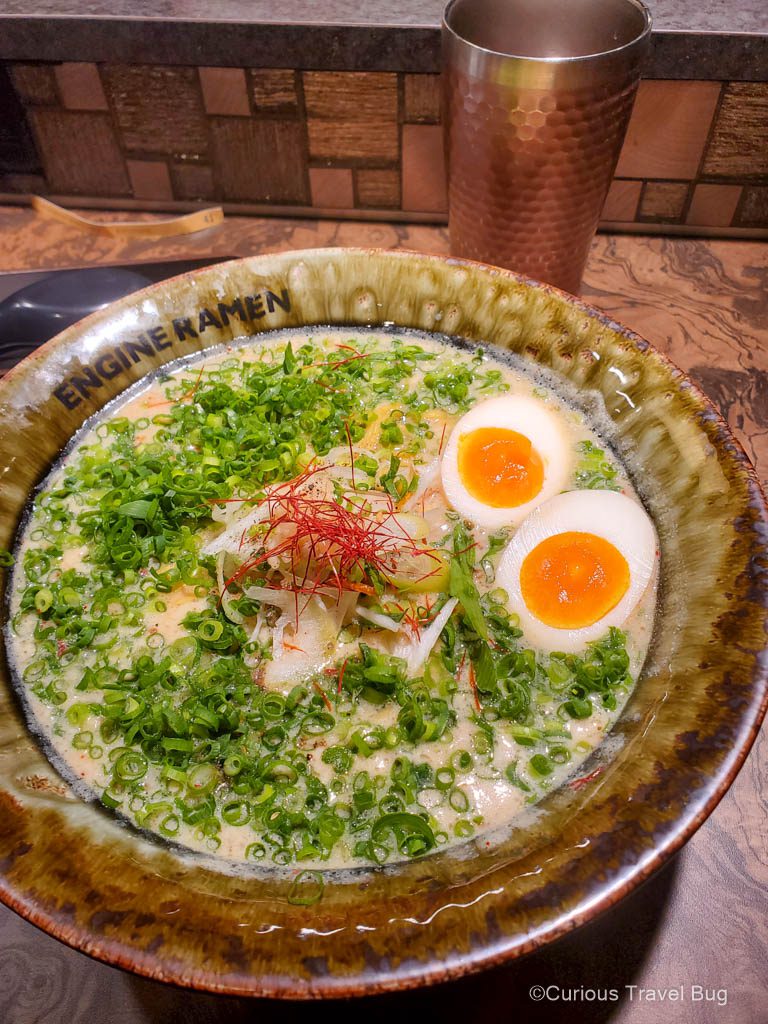
Ramen from Kyoto Engine Ramen
The Perfect Three Day Itinerary for Kyoto, Japan
For this Kyoto itinerary, you will need three full days so plan on arriving in Kyoto the night before this itinerary starts and leaving on the fourth day. I fit Kyoto into my two weeks in Japan by arriving from Osaka the night before and going to Hiroshima the day after spending 3 full days in Kyoto. I visited Nara as a day trip from Osaka but if you are not staying in Osaka, I recommend adding an extra day to this itinerary to visit Nara.
Day 0: Arrive in Kyoto and See the Gion District
Arrive in Kyoto for the evening and check in to your hotel. I stayed at the Granbell Hotel and highly recommend it. The location was amazing for exploring the Gion District and was very close to the main subway and bus lines, making it easy to navigate around Kyoto. It was my favourite hotel I stayed at in Japan.
After checking in, grab some dinner. I recommend udon at Mimikou and then seeing Yasaka Shrine lit up at night. Luckily, Yasaka Shrine is open at all hours so you can explore even after most others are closed. It’s also a great time to check out the Gion District at night when there are fewer crowds. If you want a more in depth experience, there is a night walking tour of Gion. Head back to the Granbell Hotel and enjoy soaking in the onsen to let the jetlag melt away.

Day 1: Hiking Fushimi Inari and Visiting Uji
Fushimi Inari and Uji are both easy to visit as they are on the same train line. If you don’t feel like venturing to Uji today, use your afternoon to join a tea ceremony or embrace your inner samurai.
Hiking at Fushimi Inari Taisha Shrine
Fushimi Inari Shrine is one of Kyoto’s most famous spots. With thousands of vermillion torii gates cascading up and down the mountainside, you will soon see why. It was one of my favourite things I did while visiting Kyoto.

To visit Fushimi Inari, I recommend going as early as possible. It’s easy to get to as there are two train stations, one is on the Keihan Main Line and one on the Nara Line. I had terrible jetlag so I was awake early and at Fushimi Inari by 7 am. If you arrive later the bottom of the trail will be packed with people but by hiking up the mountain you should be able to find some space to yourself.
Hiking Fushimi Inari took me about 2 hours going at a slow pace. I recommend taking some change as there are vending machines as well as souvenirs you can buy on the top of the mountain.
One of my favourite souvenirs I bought in Japan I purchased here for about 300 yen. A small wooden sake cup with the image of a fox burned into it.
Hiking through the torii gates here feels magical, especially on top of the mountain. The forest here is beautiful, walking through bamboo and cedar trees.
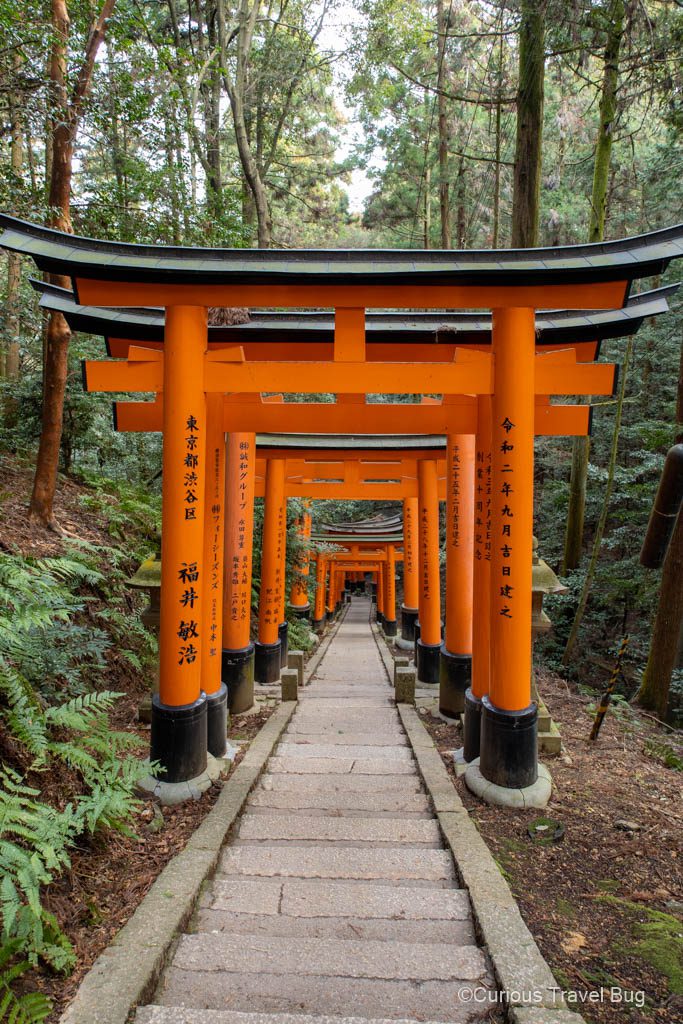
There are many smaller shrines on your walk with fox sculptures decorating the mountain. The fox, or kitsune, is a symbol of Fushimi Inari as it is the deity of farmers and the rice harvest, to which Fushimi Inari Shrine is dedicated to.

Mossy kitsune (fox) guarding the shrine
To save time, I took a smaller back trail down the mountain to avoid oncoming pedestrians and repeating what I had already seen.
After hiking Fushimi Inari, you may want to spend some time exploring the shops or the street food here. I found the food pretty expensive but it smelled very yummy if you are looking for lunch options.

Spending an Afternoon in Uji
I was done with Fushimi Inari by 10 am but even if you started your day later, you should have time to head to nearby Uji. You can reach Uji in 30 minutes on the Nara Line from Inari Station.
Upon arriving in Uji, I recommend heading for Byodoin Temple, a UNESCO World Heritage Site. On the way, make sure to walk by the iconic Uji Bridge for a great view of the city and the mountains behind it.

You may recognize Byodoin Temple when you see it as it is featured on the 10 yen coin. The Phoenix Hall sits with a matcha-coloured pond in front of it and is stunning in person. You can pay extra to do a guided tour through the hall. The Byodoin Temple grounds also has the fantastic Hoshokan Museum. This museum contains many national treasures including a pair of phoenix statues as well as 26 Praying Bodhisattva on Clouds, which were the highlight for me.

After exploring the temple, it’s worth exploring some of the tea shops around the city. Uji is famous for its green tea and there are many places to try Uji green tea in the city. Unfortunately, the wait times for some of the tea houses can be an hour or more so you may need to try a couple before you find a seat. Nakamura Tokichi, Matcha Roastery, and Itoh Kyuemon are a few good options. I ate at Itoh Kyuemon and enjoyed it.
Head back to Kyoto and have dinner in the city. I enjoyed a stroll across the river and dinner at Kyoto Engine Ramen. I ended the day with a stop at the convenience store to get supplies for an early breakfast.
Day 2: Exploring the Temples and Shrines of Kyoto
Today is a full day of exploring the most famous temples of Kyoto, including walking the Philosopher’s Path. Once again, I started this day very early to see some iconic views of Kyoto without the crowds.
Today was a big walking day and I ended up walking almost 20 km (12.4 miles). From point to point it doesn’t seem that far but there is quite a bit of walking at each site.
Yasaka Pagoda, Sannezaka Road, and Exploring Higashiyama
Start your morning by exploring the near-empty roads of the Higashiyama District. Some of the most iconic views here are of the Yasaka Pagoda from Ninenzaka Road and the view from Sannezaka Road. It’s worth taking your time to explore a bit here because by the time you are done at the next stop, the streets will be full. And truly, the streets of Gion and Higashiyama feel magical when you have them to yourselves.

I also made a stop at Yasui Kampiragu Shrine which has a power stone covered in paper amulets. Crawling through the hole and back again is said to end bad relationships and initiate good ones. Another unique temple is Yasaka Koshin-do Temple, famous for the three wise monkeys and colourful balls that decorate the temple.

Kiyomizu-dera Temple
I was at Kiyomizu-dera Temple by 7 am. Being this early, the temple was almost empty. By the time I left 1.5 hours later, the streets around it were packed with tour groups.

Kiyomizu-dera Temple is one of the most iconic temples of Kyoto. Kiyomizu-dera Temple is a 1200-year-old World Heritage Site in Kyoto’s Higashiyama mountains. I loved exploring the temple here and seeing views of Kyoto from the raised platforms the temple is built on. There are also many trails in the forest behind the temple and a nice walking path to Kiyomizu-dera Koyasunoto Pagoda.

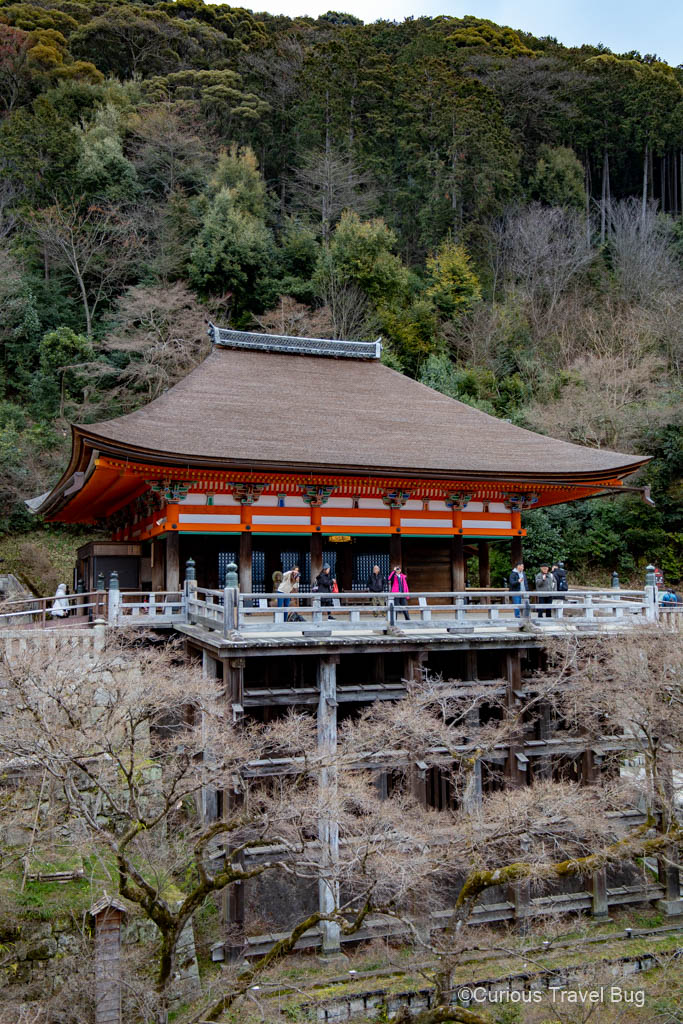

After you are done at Kiyomizu-dera, visit Starbucks Kyoto Ninenzaka Yasaka Chaya. This location is famous for being the first Starbucks in Kyoto to have a tatami mat seating area. The location is beautiful and if you collect Starbucks city mugs, the Kyoto one is gorgeous (full disclosure: I’m drinking tea from one as I’m writing this). For a Japanese brand of coffee, check out % ARABICA Kyoto Higashiyama or here Kyoto Kiyomizu, both located close to Kiyomizu-dera.
Yasaka Shrine and Maruyama Park
Even though you have seen Yasaka Shrine at night, it’s worth visiting during the day as well. Yasaka Shrine has a dance stage where you may get lucky and see dancers performing. There are also multiple small shrines here to visit.

After exploring Yasaka Shrine, walk through to the adjacent Maruyama Park. This is one of the most famous spots in Kyoto for cherry blossoms but it is beautiful any time of year. If you are into spotting unique manhole lid covers, there is a “pokelid” here to discover that has Pokemon on it.
Chion-in Temple
Located right next to Maruyama Park, Chion-in was probably my favourite temple I explored today. The large Sanmon Gate and massive staircase make a major impression upon arrival. The grounds here are expansive and it took me about an hour and a half to explore the temple and gardens.

Chion-in Temple is famous for its nighttime illuminations in spring and autumn. The Hojo Garden is an especially beautiful traditional Japanese garden that was created in the early Edo period. One of the highlights here was the Nightingale floor that lines the corridor between the Goeido Hall to Assembly Hall. This floor makes the sound of the Nightingale no matter how softly you try to walk across it.
Nanzen-ji Temple
The walk between Chion-in and Nanzen-ji is about 20 minutes (1.6 km). I stopped at a 7-11 to grab some sandwiches for lunch and viewed the Keage Incline, which is famous during sakura season because of all the cherry blossoms that line the river.

At Nanzen-ji Temple you do have to pay for entry but you can see quite a bit for free including the large gate and the Suirokaku aqueduct. Just like Chion-in and Kiyomizu-dera, this temple complex is large and you can easily spend a couple hours here. I was happy with just exploring the free sights before moving on.

Philosopher’s Path

The Philosopher’s Path is probably Kyoto’s most famous walking path. From Nanzen-ji Temple it is about 10 minutes to the start of the path. I walked along the path to get to Ginkakuji (Silver Pavilion). The path is nice to explore as there are many shops, temples, and shrines you can stop at on your walk. My favourite was Otoyo Shrine. Otoyo Shrine has statues of mice and some other animal guardians including snakes and monkeys. If you are collecting goshuin (temple stamps) the stamp includes mice and was one of the most unique goshuin I received in Japan.

Ginkakuji (The Silver Pavilion)
My final big stop was at Ginkakuji, also known as the Silver Pavilion or Higashiyama Jisho-ji. Located at the end of the Philosopher’s Path, this is one temple not to miss while you are in Kyoto.
Unlike the Golden Pavilion, the Silver Pavilion is not coated in silver. It’s a beautiful building nonetheless and the temple grounds are worth the visit. The highlight for me here was the moss garden and sand garden. The sand garden has a large sand dome known as the moon viewing platform that is meticulously raked and maintained.

After exploring Ginkakuji, get a bus or taxi back to your hotel as Ginkakuji is quite far from Gion. I took the opportunity to take the bus to the Pokemon Centre in Kyoto to hunt for a Kyoto-exclusive Pikachu. The nearby Disney Store also has an exclusive Minnie Mouse. Surprisingly, I enjoyed shopping in Kyoto far more than in Tokyo. If you have time it’s worth stopping in at Hands Kyoto as you can pick up interesting stationary or household goods.
Day 3: Visiting Arashiyama and the Golden Pavilion
Arashiyama is in the western part of Kyoto and after the areas explored yesterday, the second most popular place in Kyoto. It isn’t walking distance from the main hotel areas of Kyoto so you will likely need to take a bus or trolley to reach Arashiyama.
I arrived in Arashiyama at 8 am and it was almost empty and very peaceful. When I left the area around noon, it was packed with people and difficult and slow to walk through.

Arashiyama Bamboo Forest
The main reason most people visit Arashiyama is to see the bamboo forests. I recommend heading straight for the bamboo forests so that you are there before the crowds.
There are a couple of bamboo forests in Arashiyama and they are both quite quick to walk around. Sagano Bamboo Grove is fairly small and has younger bamboo but is worth a visit. From there walk towards Ogura Pond and up towards Nison-in Temple to get a feel for the historic buildings in Arashiyama.

Afterwards, head towards Arashiyama Bamboo Forest which is the main bamboo forest and the one you have likely seen in photos. It doesn’t take very long to go through the forest as it is fairly short. Walk through the park to experience Arashiyama Park Observation Deck and get fantastic views of the gorge.

Tenryu-ji Temple
Tenryu-ji Temple was a highlight of Arashiyama for me. The grounds are not large but they are beautiful as the Sogenchi Garden has many different blooms and carefully designed water and moss features.
 Tenryu-ji Temple, Kyoto
Tenryu-ji Temple, Kyoto Pond at Tenryu-ji Temple
Pond at Tenryu-ji Temple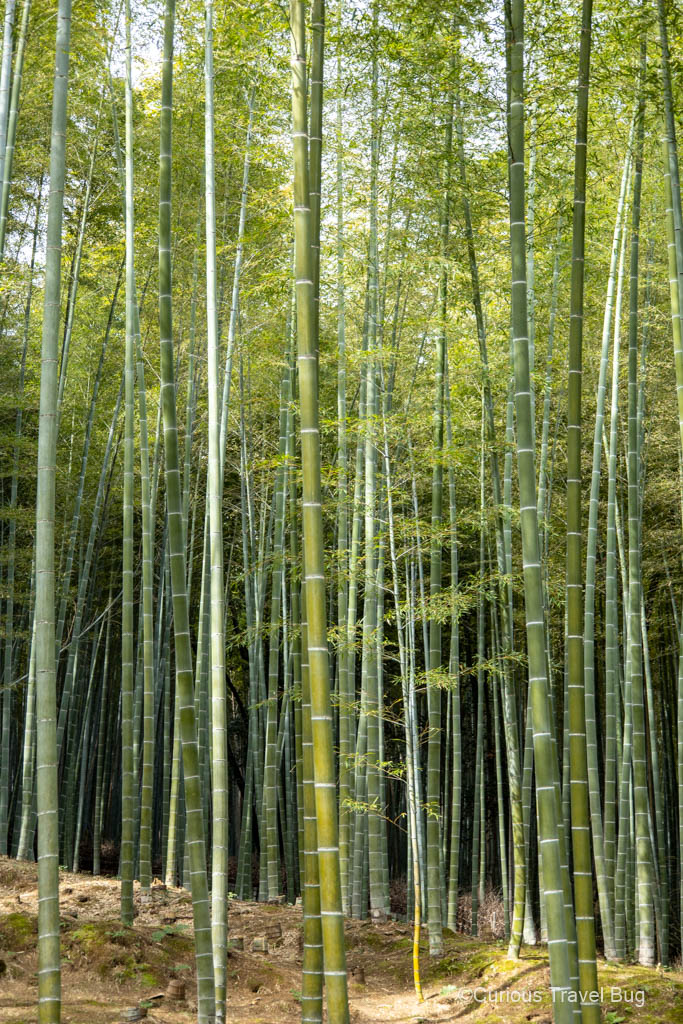 View of the bamboo grove from Tenryu-ji
View of the bamboo grove from Tenryu-ji Looking at Tenryu-ji Temple
Looking at Tenryu-ji Temple
This UNESCO World Heritage Site was founded in 1339, though fires have destroyed all the original buildings. Walking around the pond on the ground offers up many scenic views and if you walk to the top of the garden you will be able to view the bamboo forest as well as have views over the temple and mountains behind it.
This temple is a great place to plan to have lunch. Make sure you make a reservation in advance to try Zen vegetarian cuisine.
Togetsukyo Bridge
After exploring Tenryu-ji Temple, walk towards Togetsukuo Bridge and Monkey Park. It’s on the way and offers nice views of the Katsura River and mountains in Arashiyama.

Arashiyama Monkey Park
Arashiyama Monkey Park is located across the Togetsukyo Bridge. If you are visiting, plan on spending at least an hour here. The walk up the mountain is a pretty serious little climb and is quite steep in some parts.
When you reach the top, there are plenty of Japanese Macaques roaming around. There is a feeding area where you can buy food to feed to the macaques but stay separated by wire fencing for safety. If you are collecting souvenir stamps, there is one located inside the feeding house.

Even if you skip feeding the macaques, you will have plenty of opportunities to see the monkeys. The Japanese Macaques that call this mountain home are very habituated to humans and will approach quite closely. They are wild animals and you should not attempt to pet them as they have very large teeth.
Kinkaku-ji (Golden Pavilion)
After Arashiyama Monkey Park I intended to stay in Arashiyama and explore more but it was uncomfortably packed with people so I decided to head to Kinkaku-ji instead. You can reach it in about 40 minutes on transit, though unfortunately, there is no direct route.
Kinkaku-ji is one of the most popular temples in Kyoto so expect it to be busy. Unlike other temples, you cannot freely wander and must move along the path in one direction.
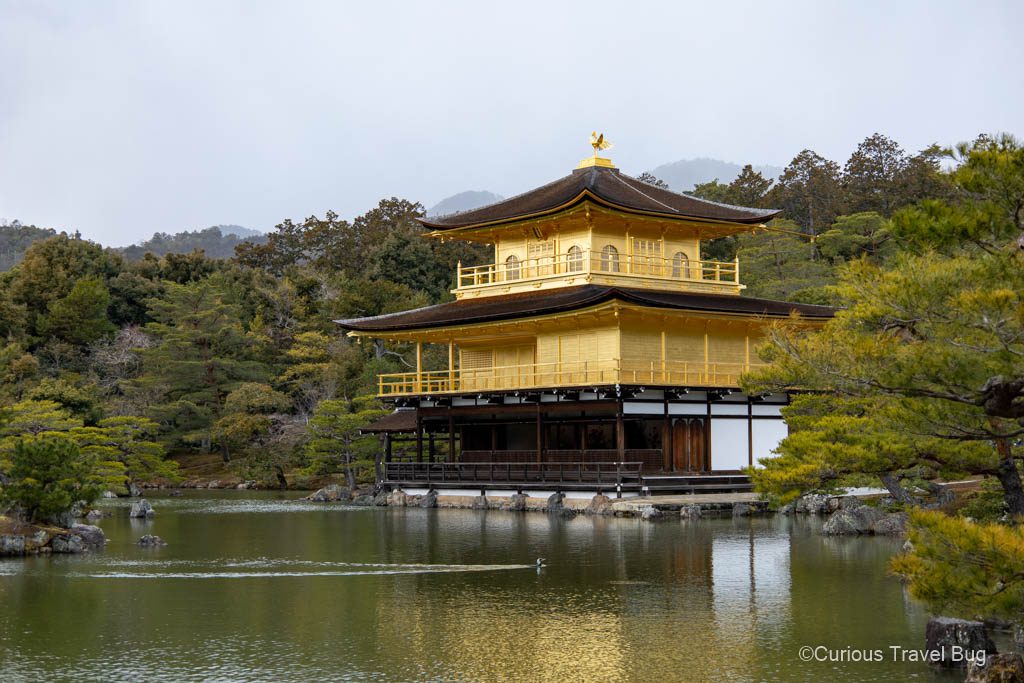
The Golden Pavilion sitting above the pond is quite beautiful but is a bit underwhelming compared to other temples on this Kyoto itinerary. Walking around the grounds takes you through some moss gardens and by ponds. I was happy to visit but ultimately felt because you cannot go inside any of the buildings that it was less impactful than other sights in Kyoto.
Kitano Tenmangu Shrine
I finished my day by heading to Kitano Tenmangu Shrine, only a 15-minute walk from Kinkaku-ji. This shrine wasn’t on my radar before visiting Kyoto but it is known for its plum blossoms in spring and maple leaves during autumn.

Kitano Tenmangu Shrine is worth visiting if you enjoy gardens. The gardens are paid entry but you are free to explore the rest of the buildings at the shrine.
After exploring the gardens here, head back towards your hotel and enjoy dinner on your final night in Kyoto!
Day 4: Kyoto Imperial Palace and Depart Kyoto
Depending on when you leave today, you should have time to see a couple more sights in Kyoto. It’s a good opportunity to join a morning food tour of Nishiki Market and follow it up with a visit to the Imperial Palace. I forwarded my large luggage with the help of my hotel. I also stored my smaller luggage at my hotel and picked it up before heading onward to Hiroshima.
If you have time, you can also fit in a visit to Hozo-ji Temple which has arguably, the most unique goshiun in Kyoto. The typical goshuin here features a skull stamp, however, I was able to get a special stamp available only that weekend that was in honour of the Nirvana scroll that was on display.

The Kyoto Imperial Palace is far from other places and the actual palace is quite vast so you may want to get a bus to save on walking.
There are many gardens and lots of park space surrounding the Imperial Palace but the highlight is the palace itself. The buildings here are enormous and there are beautiful gardens inside the walls of the Imperial Palace.

After touring the Imperial Palace, pick up any luggage you stored at the hotel and head to your next destination!
With Extra Time in Kyoto
You can easily spend more than three days in Kyoto. Nara is one of the most popular day trips from Kyoto and can easily be visited on a day trip from Kyoto. Another popular but long day trip is to visit Miyajima Island near Hiroshima. Miyajima was one of my highlights in Japan. I wish I had more time in Kyoto to go to the northern part of Kyoto to do the Kibune to Kurama hike.
Spending Three Days in Kyoto
Kyoto feels like quintessential Japan. I had read so many people on the internet (especially on Reddit!) discouraging people from visiting Kyoto. I was so happy that I included Kyoto in my two-week Japan itinerary. Even though Kyoto is heavily touristed, you can still find moments in the city where you are mostly alone. It’s a beautiful city and I highly recommend you visit Kyoto, at least on your first visit to Japan.
Visiting Kyoto reminded me that you have to go with your gut feeling when you travel and not always listen to the crowd that tells you some variation of “it was better before, it isn’t worth it now.” Kyoto is still worth it and its historic areas are still there waiting to prove it to you.
Like this post? Pin it for later!













Your Kyoto itinerary perfectly captures the essence of the city – can’t wait to follow this guide on my own trip!
Thanks for your comment! Glad this post on Kyoto is useful for you.
How realistic is day 2? How long did you take?
Hello, Day 2 on this itinerary is exactly as I experienced it that day so it is realistic. Day 2 for me was 7am-430pm, plus dinner after. It is a long day and there is 20km of walking. I was really excited to experience Kyoto and I had bad jet lag flying from Toronto so I was up early and wanted to take in as much as possible. If you think that it might be too much in one day, I would start the day 2 itinerary on day 1 instead and anything I didn’t get to I would do after visiting Fushimi Inari instead of going to Uji for an afternoon. This should give you some flexibility and while still allowing the possibility of visiting Uji if you are able to see everything the day before.